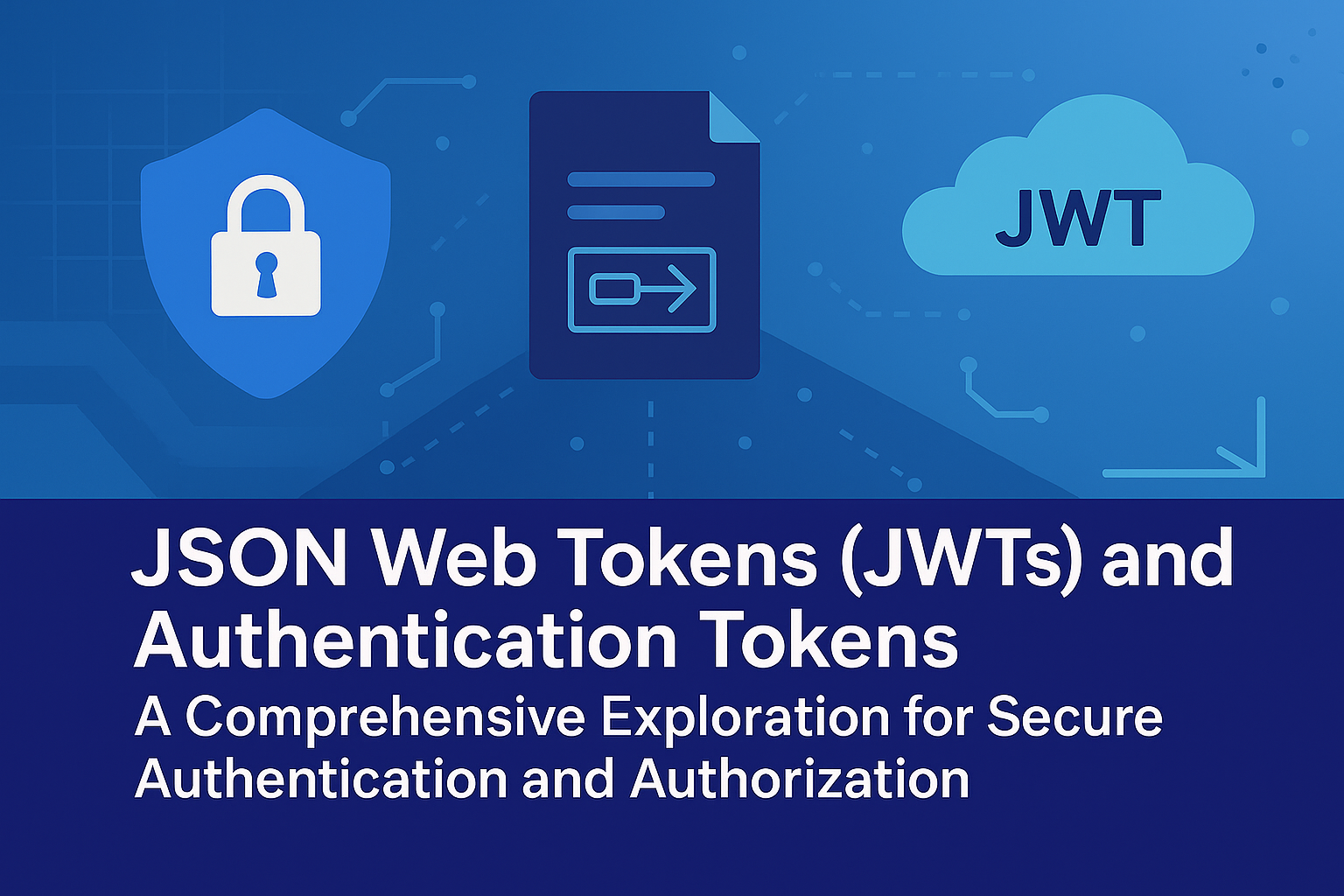Introduction
JSON Web Tokens (JWTs) are a widely adopted standard for secure authentication and authorization in distributed systems. As a compact, self-contained mechanism, JWTs enable stateless, scalable, and secure communication between parties by encoding user identity and permissions in a JSON-based format. They are integral to modern applications, ensuring secure access to resources in web, mobile, and microservices architectures. This analysis provides a detailed examination of JWTs, their structure, mechanisms, use cases, advantages, limitations, and strategic considerations. It integrates prior concepts from distributed systems, such as the CAP Theorem (prioritizing availability and partition tolerance in token validation), consistency models (eventual consistency in distributed token stores), consistent hashing (for load balancing token validation services), idempotency (for safe token operations), unique IDs (for token identifiers), heartbeats (for service liveness), failure handling (e.g., token expiration handling), single points of failure (SPOFs) avoidance (through distributed validation), checksums (for token integrity), GeoHashing (for location-based access), rate limiting (to prevent token abuse), Change Data Capture (CDC) (for auditing token usage), load balancing (for token endpoints), quorum consensus (for distributed token stores), multi-region deployments (for global access), and capacity planning (for token infrastructure). The discussion emphasizes real-world applications, performance metrics, and trade-offs to guide system architects in implementing secure, scalable authentication systems.
What is a JSON Web Token (JWT)?
A JSON Web Token (JWT) is an open-standard (RFC 7519) token format used to securely transmit information between parties as a JSON object. It is primarily employed for authentication (verifying user identity) and authorization (determining access rights). JWTs are compact, URL-safe, and self-contained, containing all necessary information about a user or session, eliminating the need for server-side session storage.
Structure of a JWT
A JWT consists of three parts, separated by dots (.):
- Header: Specifies the token type (JWT) and signing algorithm (e.g., HMAC SHA-256 or RSA).
- Example: {“alg”: “HS256”, “typ”: “JWT”}
- Encoded as Base64Url: eyJhbGciOiJIUzI1NiIsInR5cCI6IkpXVCJ9
- Payload: Contains claims (key-value pairs) about the user and metadata, such as issuer (iss), subject (sub), expiration (exp), and custom claims (e.g., roles).
- Example: {“sub”: “user123”, “name”: “John Doe”, “exp”: 1739723400, “roles”: [“admin”]}
- Encoded as Base64Url: eyJzdWIiOiJ1c2VyMTIzIiwibmFtZSI6IkpvaG4gRG9lIiwiZXhwIjoxNzM5NzIzNDAwLCJyb2xlcyI6WyJhZG1pbiJdfQ
- Signature: Ensures integrity by signing the encoded header and payload with a secret key (for HMAC) or private key (for RSA).
- Example (HMAC-SHA256): HMACSHA256(base64UrlEncode(header) + “.” + base64UrlEncode(payload), secret)
- Encoded: abc123signature
The final JWT looks like: eyJhbGciOiJIUzI1NiIsInR5cCI6IkpXVCJ9.eyJzdWIiOiJ1c2VyMTIzIiwibmFtZSI6IkpvaG4gRG9lIiwiZXhwIjoxNzM5NzIzNDAwLCJyb2xlcyI6WyJhZG1pbiJdfQ.abc123signature
Key Characteristics
- Compact: Small size (e.g., < 1KB) for easy transmission in HTTP headers or URLs.
- Self-Contained: Includes all necessary information, enabling stateless validation.
- Secure: Signed to prevent tampering; optionally encrypted (JWE) for confidentiality.
- Interoperable: Supported across platforms (e.g., Node.js, Java, Python).
JWT Authentication and Authorization Mechanism
Authentication Workflow
- User Login: A user provides credentials (e.g., username/password) to an authentication server (e.g., via OAuth 2.0 or OpenID Connect).
- Token Issuance: The server validates credentials, generates a JWT with claims (e.g., user ID, roles), signs it with a secret or private key, and returns it to the client.
- Token Usage: The client includes the JWT in the Authorization header (e.g., Bearer <token>) for subsequent API requests.
- Token Validation: The server verifies the JWT’s signature, checks claims (e.g., expiration), and grants access if valid.
- Access Control: Claims like roles or scopes determine what resources the user can access.
Authorization
- Role-Based Access Control (RBAC): Claims like roles: [“admin”] allow servers to enforce permissions (e.g., only admins access /admin endpoints).
- Attribute-Based Access Control (ABAC): Claims like department: “HR” enable fine-grained policies.
- GeoHashing Integration: Location-based claims (e.g., region: “us-east”) restrict access to geo-specific resources.
Security Mechanisms
- Signature Verification: Uses HMAC-SHA256 (symmetric key) or RSA/ECDSA (asymmetric key) to ensure integrity. Checksums (e.g., SHA-256) validate token content.
- Expiration: The exp claim prevents indefinite token use (e.g., 1-hour validity).
- Issuer/Audience Validation: iss and aud claims ensure the token’s origin and intended recipient.
- Nonce: Prevents replay attacks by including unique IDs (e.g., Snowflake IDs).
- Encryption (JWE): Optional for sensitive payloads, using AES for confidentiality.
Mathematical Foundation
- Signature Generation: Signature=HMACSHA256(base64Url(header)+”.”+base64Url(payload),secret) \text{Signature} = \text{HMACSHA256}(\text{base64Url(header)} + “.” + \text{base64Url(payload)}, \text{secret}) Signature=HMACSHA256(base64Url(header)+”.”+base64Url(payload),secret), with computational cost ~1μs.
- Validation Latency: Latency=decode_time+signature_verify_time+claim_check_time \text{Latency} = \text{decode\_time} + \text{signature\_verify\_time} + \text{claim\_check\_time} Latency=decode_time+signature_verify_time+claim_check_time, e.g., 0.1ms + 0.5ms + 0.1ms = 0.7ms.
- Storage: Minimal (~1KB/token), but token databases (e.g., for revocation) scale with users (e.g., 1GB for 1M tokens).
Integration with Prior Concepts
- CAP Theorem: JWT validation favors AP, as tokens are stateless and verifiable across regions (eventual consistency in token revocation lists).
- Consistency Models: Strong consistency for signature verification, eventual for revocation checks in distributed stores.
- Consistent Hashing: Distributes token validation requests across servers.
- Idempotency: Ensures safe token retries (e.g., duplicate requests ignored).
- Heartbeats: Monitors validation service liveness (< 5s detection).
- Failure Handling: Handles invalid/expired tokens via retries or refresh tokens.
- SPOFs: Avoided by distributing validation services across regions.
- Checksums: SHA-256 ensures token integrity.
- GeoHashing: Restricts token access to specific regions.
- Rate Limiting: Token Bucket caps authentication requests (e.g., 100 req/s/user).
- CDC: Logs token issuance/revocation for auditing.
- Load Balancing: Least Connections distributes validation traffic.
- Quorum Consensus: Used in distributed token blacklists for consistency.
- Multi-Region: Validates tokens globally with < 50ms latency.
- Capacity Planning: Estimates servers for validation (e.g., 10 nodes for 1M req/s).
Use Cases with Real-World Examples
1. Single Sign-On (SSO) in Enterprise Applications
- Context: A multinational corporation needs employees to access multiple services (e.g., email, HR, CRM) with one login, ensuring security and scalability.
- Implementation:
- Setup: An Identity Provider (IdP) like Okta issues JWTs via OAuth 2.0. Tokens include claims (sub: employee123, roles: [“manager”], exp: 1hr).
- Workflow: Employee logs into Okta, receives a JWT, and uses it to access services like Salesforce or Microsoft 365. Services validate tokens using Okta’s public key (RSA).
- Security: Tokens signed with RSA-2048, validated with checksums (SHA-256). Rate limiting caps login attempts (10/min/user). CDC logs token usage to Kafka for auditing.
- Scalability: Consistent hashing distributes validation across 10 nodes. Multi-region deployment ensures < 50ms latency globally.
- Performance: < 1ms validation latency, 1M logins/day, 99.999% uptime.
- Trade-Off: Stateless JWTs reduce server load but require revocation lists (e.g., Redis, 1GB for 1M tokens).
- Strategic Considerations: Ideal for enterprises needing seamless, secure access across services, with eventual consistency for revocation.
2. API Authentication in E-Commerce Platforms
- Context: An online retailer authenticates API requests from mobile apps to access user profiles, orders, and payments.
- Implementation:
- Setup: A custom auth server issues JWTs post-login (sub: user456, scopes: [“read:profile”, “write:orders”], exp: 30min).
- Workflow: Mobile app sends JWT in Authorization header for API calls. Backend verifies signature (HMAC-SHA256) and scopes. GeoHashing restricts access to user’s region (e.g., region: us-west).
- Security: Tokens encrypted (JWE) for sensitive data, with nonce to prevent replays. Rate limiting (Token Bucket) caps API calls (1000/min/user). Heartbeats monitor auth servers.
- Scalability: Load balancing (Least Connections) across 5 nodes handles 500,000 req/s.
- Performance: < 0.7ms validation latency, 10M API calls/day, 99.99% uptime.
- Trade-Off: Fast validation but revocation requires distributed stores (e.g., DynamoDB with quorum consensus).
- Strategic Considerations: Suits APIs needing fast, stateless auth with fine-grained permissions.
3. Microservices Authorization in a Streaming Platform
- Context: A video streaming service uses microservices for recommendations, billing, and playback, requiring secure inter-service communication.
- Implementation:
- Setup: An auth service issues JWTs to microservices (sub: service_recommend, scopes: [“read:content”], exp: 1hr).
- Workflow: Recommendation service uses JWT to access content metadata from a catalog service. Tokens validated with public key (ECDSA). CDC tracks token usage for compliance.
- Security: TLS 1.3 encrypts communication, checksums ensure integrity. Quorum consensus in a token blacklist (e.g., etcd) handles revocations.
- Scalability: Multi-region validation ensures < 100ms latency globally, with consistent hashing for load distribution.
- Performance: < 1ms validation latency, 1M inter-service calls/day, 99.999% uptime.
- Trade-Off: Stateless tokens simplify scaling but increase complexity for revocation management.
- Strategic Considerations: Ideal for microservices needing secure, decentralized authorization.
4. IoT Device Authentication
- Context: An IoT smart home system authenticates 1M devices to ensure secure control of appliances.
- Implementation:
- Setup: Devices receive JWTs from a central auth server (sub: device789, region: GeoHash(37.7749,-122.4194), exp: 24hr).
- Workflow: Devices send JWTs to control APIs (e.g., turn on lights). Servers validate tokens, checking GeoHash for location-based access. Rate limiting prevents abuse (100 req/min/device).
- Security: Tokens signed with ECDSA, validated with checksums. CDC logs device access to Kafka for monitoring.
- Scalability: 10 validation nodes handle 1M devices, with multi-region support for global homes.
- Performance: < 1ms validation latency, 1M requests/s, 99.999% uptime.
- Trade-Off: Stateless JWTs reduce server state but require secure key management.
- Strategic Considerations: Suits IoT for lightweight, location-aware authentication.
Advantages of JWTs
- Statelessness: No server-side storage, reducing database load (e.g., 90% less overhead vs. session stores).
- Scalability: Validates across distributed systems with consistent hashing, handling 1M req/s.
- Flexibility: Custom claims support RBAC/ABAC (e.g., roles, scopes).
- Interoperability: Works across platforms (e.g., Node.js, Java) and protocols (OAuth 2.0).
- Security: Signed tokens prevent tampering; encryption (JWE) protects sensitive data.
Limitations of JWTs
- Revocation Complexity: Requires distributed blacklists (e.g., Redis with eventual consistency), adding 10–15% overhead.
- Size Overhead: Larger than opaque tokens (e.g., 1KB vs. 100B), impacting bandwidth.
- Security Risks: Improper key management or weak algorithms (e.g., HS256 with weak secrets) risk breaches.
- Expiration Trade-Off: Short-lived tokens (e.g., 30min) enhance security but require frequent refresh; long-lived increase risk.
- No Built-In Encryption: Payloads are readable unless JWE is used, risking exposure.
Trade-Offs and Strategic Considerations
- Statelessness vs. Revocation:
- Trade-Off: Stateless JWTs scale but complicate revocation (e.g., Redis blacklist adds 10ms latency).
- Decision: Use stateless for high-scale APIs, stateful tokens (e.g., Redis sessions) for revocable sessions.
- Interview Strategy: Justify JWTs for microservices, stateful for banking apps.
- Security vs. Performance:
- Trade-Off: Strong algorithms (RSA-2048) ensure security but add 0.5ms latency; weaker (HS256) are faster but riskier.
- Decision: Use RSA for sensitive apps (e.g., banking), HS256 for low-risk.
- Interview Strategy: Propose RSA for e-commerce, HS256 for internal tools.
- Token Size vs. Bandwidth:
- Trade-Off: Large JWTs (1KB) increase network usage (e.g., 1GB/s for 1M req/s); smaller tokens reduce overhead but limit claims.
- Decision: Optimize claims for bandwidth-sensitive apps (e.g., IoT).
- Interview Strategy: Highlight compact JWTs for mobile APIs.
- Expiration vs. User Experience:
- Trade-Off: Short expiration (30min) enhances security but requires refresh tokens; longer (24hr) risks compromise.
- Decision: Use short for sensitive apps, longer for user-friendly apps.
- Interview Strategy: Propose short-lived for banking, longer for streaming.
- Global Access vs. Latency:
- Trade-Off: Multi-region validation ensures global access but adds 50–100ms latency; single-region is faster but less resilient.
- Decision: Use multi-region for global apps, single for regional.
- Interview Strategy: Justify multi-region for IoT, single for local services.
Advanced Implementation Considerations
- Deployment: Deploy auth servers on Kubernetes with 10 nodes, using Redis for blacklists and Kafka for audit logs.
- Configuration:
- Token Lifetime: 30min–24hr based on security needs.
- Signing: RSA-2048 or ECDSA for high security, HS256 for performance.
- Claims: Include sub, exp, iss, aud, and custom scopes.
- Performance Optimization:
- Cache public keys in Redis for < 0.5ms validation.
- Use GZIP compression for large JWTs (reduces size by 50%).
- Load balance with Least Connections for < 1ms latency.
- Monitoring:
- Track validation latency (< 1ms), request rate (1M/s), and token errors with Prometheus/Grafana.
- Monitor blacklist size (> 1GB triggers scale-out) via CloudWatch.
- Security:
- Encrypt payloads with JWE for sensitive data.
- Use TLS 1.3 for transport security.
- Implement RBAC/IAM for token issuance.
- Testing:
- Stress-test with JMeter for 1M validations/s.
- Validate failover (< 5s) with Chaos Monkey.
- Test replay attacks with nonce scenarios.
Discussing in System Design Interviews
- Clarify Requirements:
- Ask: “What’s the user scale (1M users)? Latency target (< 1ms)? Security needs (RSA vs. HS256)? Global or regional?”
- Example: Confirm 1M users for e-commerce with low-latency auth.
- Propose Design:
- JWT: “Use for stateless API auth with RSA signing.”
- Opaque Tokens: “Use for stateful apps with Redis sessions.”
- Example: “For streaming platform, implement JWT with scopes for microservices.”
- Address Trade-Offs:
- Explain: “JWTs scale but complicate revocation; opaque tokens simplify revocation but require state.”
- Example: “Use JWTs for microservices, sessions for banking.”
- Optimize and Monitor:
- Propose: “Cache keys in Redis, monitor latency with Prometheus.”
- Example: “Track e-commerce auth latency for optimization.”
- Handle Edge Cases:
- Discuss: “Mitigate token abuse with rate limiting, handle revocation with blacklists.”
- Example: “For IoT, use GeoHashing for location-based access.”
- Iterate Based on Feedback:
- Adapt: “If revocation is critical, add Redis blacklist; if latency is key, use HS256.”
- Example: “For enterprise SSO, use RSA for security.”
Conclusion
JWTs are a powerful tool for secure, stateless authentication and authorization, enabling scalable access control in distributed systems. Their compact, self-contained nature supports use cases like SSO, API authentication, microservices, and IoT, with real-world examples in enterprises, e-commerce, streaming platforms, and smart homes. Integration with concepts like consistent hashing, idempotency, CDC, and quorum consensus enhances their robustness, while trade-offs like revocation complexity and token size guide implementation. By aligning with security, scalability, and performance requirements, JWTs provide a flexible, secure solution for modern authentication needs.




